
Original Link: https://www.anandtech.com/show/2854
Gigabyte's GTX 260 Super Overclock: A GTX 275 on the Cheap?
by Ryan Smith on October 11, 2009 12:00 AM EST- Posted in
- GPUs
If you want to differentiate yourself in the crowded and competitive video card market, you have two ways to do it. One way is to offer a card with a non-stock design, using things such as different coolers or a new PCB design. The other way is to build a card that you can overclock the hell out of. Today we’re looking at an interesting card from Gigabyte that takes a little from column A, and a whole lot from Column B: The GTX 260 Super Overclock
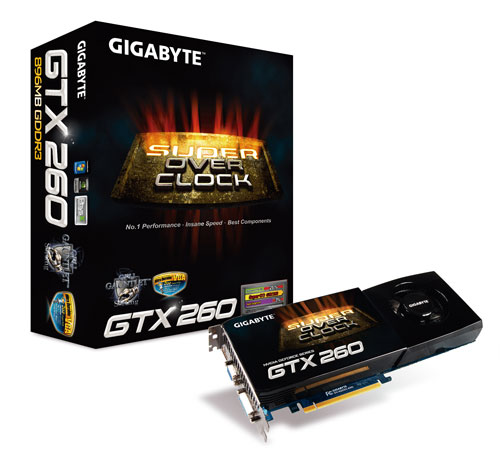
Gigabyte sells no less than three overclocked GTX 260s right now, which means they’re binning chips to assign them to the appropriate product line. Gigabyte’s formal name for this process is called “GPU Gauntlet Sorting”, which is composed of testing them with FurMark and 3DMark at various speeds, and examining their power characteristics to make sure that they aren’t going to start a small fire while in use. From the results of their binning process, they can assign chips to specific cards based on how they perform.
| GTX 285 | GTX 275 | Gigabyte GTX 260 SO | GTX 260 Core 216 | |
| Stream Processors | 240 | 240 | 216 | 216 |
| Texture Address / Filtering | 80 / 80 | 80 / 80 | 72/72 | 72/72 |
| ROPs | 32 | 28 | 28 | 28 |
| Core Clock | 648MHz | 633MHz | 680MHz | 576MHz |
| Shader Clock | 1476MHz | 1404MHz | 1500MHz | 1242MHz |
| Memory Clock | 1242MHz | 1134MHz | 1250MHz | 999MHz |
| Memory Bus Width | 512-bit | 448-bit | 448-bit | 448-bit |
| Frame Buffer | 1GB | 896MB | 896MB | 896MB |
| Transistor Count | 1.4B | 1.4B | 1.4B | 1.4B |
| Manufacturing Process | TSMC 55nm | TSMC 55nm | TSMC 55nm | TSMC 55nm |
| Price Point | $320 | $210 | $199 | $160-$199 |
From the very best of Gigabyte’s chips, you get the GTX 260 Super Overclock, the cream of the crop of their GTX 260 lineup. It comes in at 680MHz/1500MHz/2500MHz, giving it an 18% core overclock, a 21% shader overclock, and a 25% memory overclock as compared to a stock GTX 260 Core 216. And just to give you an idea of how aggressive Gigabyte is here, we’re pretty sure that makes it the fastest overclocked GTX 260 as sold by anyone, period.
What’s the significance of being so fast, you may ask? It’s what you end up beating when you overclock a GTX 260 to that degree. Above the GTX 260 in NVIDIA’s pecking order is the GTX 275, which averages around 15%-20% better performance than the GTX 260. With a GTX 260 so heavily overclocked, you can meet (and sometimes beat) a GTX 275, which is what we’ll see today with the GTX 260 Super Overclock.
And what’s the significance of being able to catch a GTX 275 with an overclocked GTX 260? Pricing. Gigabyte can build the GTX 260 Super Overclock for less than anyone can build a GTX 275 (or at least is willing to sell them for), which means that this GTX 260 that wants to be a GTX 275 sells for less than any GTX 275 we can get our hands on today, if only marginally. Gigabyte has put an MSRP of $199 on it, which is $10 less than the cheapest GTX 275 as of today.
Of course this makes it a very expensive GTX 260, but one that is priced appropriately, at least compared to other NVIDIA cards. Compared to AMD’s recent offerings however, $199 is an odd place to be. But we’ll get to that in due time.
The GTX 260 Super Overclock
In order to run a card so far out of NVIDIA’s specs, you have to build a card that equally exceeds those specifications. It’s not enough to just bin chips to find the best performers, your memory and PCB need to be capable of supporting such a chip. So while the GTX260 Super Overclock’s main claim to fame is its high clock speeds, it also has to be built as a better card than what you can get away with at stock.
To accomplish this, Gigabyte has given the card the UltraDurable treatment that many of their other high-end products get. This includes a 2oz. copper based PCB, solid capacitors, low RDS(on) MOSFETs, and ferrite core chokes. Added to that UltraDurable qualifier is that they only use “1st tier” Samsung and Hynix memory, although this is a bit of a redundant claim since those two companies provide most high-speed GDDR3 these days anyhow.
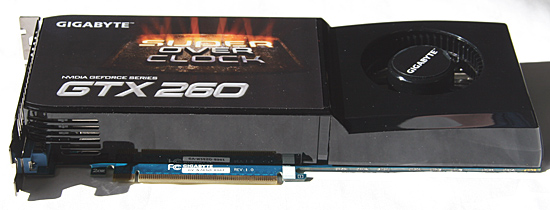
The card is otherwise indistinguishable on the outside from any other stock GTX 200 series card. Gigabyte is using the same GTX cooler, adorned with Gigabyte decals. Gigabyte has gone ahead and programmed in a different cooling profile for this card as compared to the stock GTX 260, and this along with the greater heat generated by the overclocked card means that the cooling performance will differ in spite of being the usual GTX cooler.
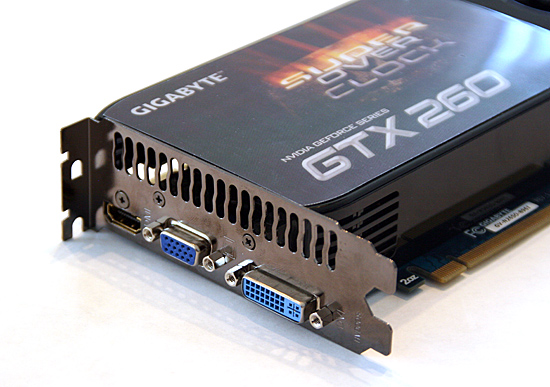
Gigabyte has used an interesting choice for the port layout on the GTX260 Super Overclock. Instead of the standard 2x DVI + TV-Out configuration, they’re using 1x DVI + VGA + HDMI out. We find this somewhat odd since the GTX 260 Super Overclock is not a card targeted for HTPC use, so the HDMI port would see little use unless someone is using an HDMI-only TV as a desktop monitor. But on the flip side, this means that a special audio-carrying DVI->HDMI dongle isn’t required to get full HDMI out.
With the different port layout comes different dongles. 1 DVI->VGA dongle is included, along with an HDMI->DVI dongle for a second DVI port. Also included is a pair of Molex->PCIe power adapters, and a S/PDIF connector cable.
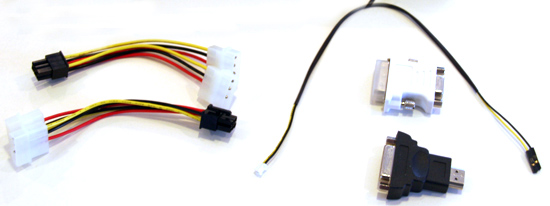
Rounding out the collection of included goodies is the obligatory manual and driver CD. Gigabyte also includes their VGA Tools Gamer Hud Lite. You won’t see this advertised on the box, which really says all that needs to be said. The NVIDIA drivers do a better job covering things here.
The warranty is listed at 3 years, which along with lifetime limited are the two most common warranty periods for higher-end video cards. Truth be told, we would have rather seen a lifetime warranty on an overclocked video card, particularly since the core speeds for this card are beyond anything the GT200b was designed and validated for. Furthermore Gigabyte’s competitors such as eVGA and BFG offer lifetime warranties on their overclocked parts, leaving Gigabyte the odd man out. 3 years is still a fair warranty, and we believe that realistically it should be good enough, but it’s just that.
The Test
| CPU: | Intel Core i7-920 @ 3.33GHz |
| Motherboard: | Intel DX58SO (Intel X58) |
| Chipset Drivers: | Intel 9.1.1.1015 (Intel) |
| Hard Disk: | Intel X25-M SSD (80GB) |
| Memory: | Patriot Viper DDR3-1333 3 x 2GB (7-7-7-20) |
| Video Cards: |
ATI Radeon HD 5870 |
| Video Drivers: |
NVIDIA ForceWare 190.62 |
| OS: | Windows 7 Ultimate 64-bit |
Crysis: Warhead
Kicking things off, we’ll start with Crysis: Warhead. Warhead is still the single most demanding game in our arsenal, with cards continuing to struggle to put out a playable frame rate with everything turned up.
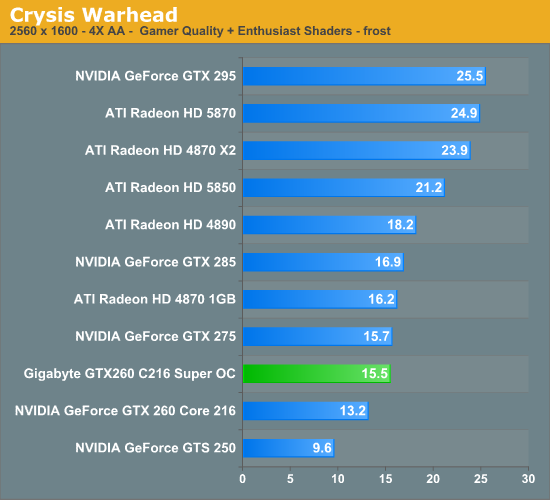
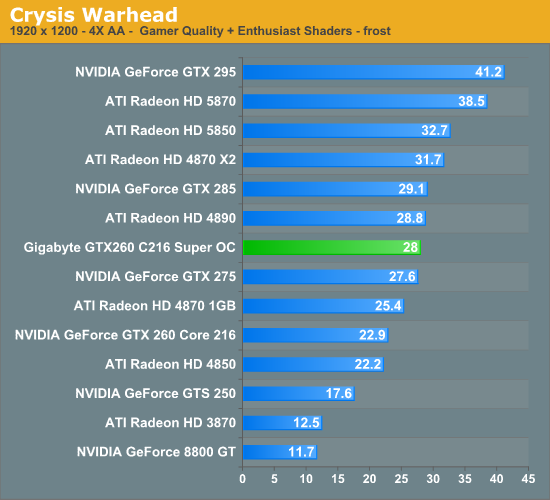
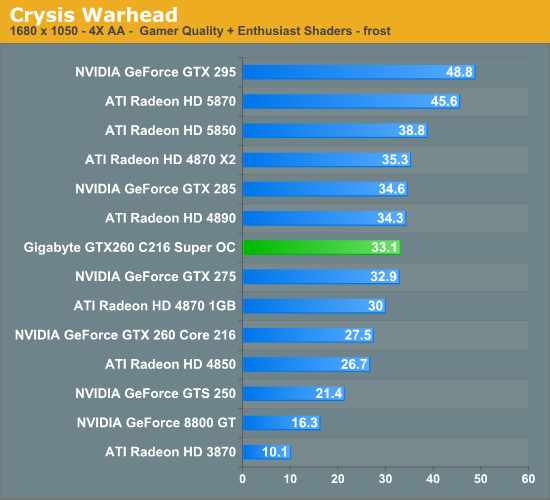
Crysis is going to set up what we’ll see is a common pattern in performance. With Gigabyte having cranked up the clocks on the GTX260 Super Overclock by such a large degree, it performs ever so slightly better than a stock GTX275.
Far Cry 2
Far Cry 2 is another foliage-heavy game. Thankfully it’s not nearly as punishing as Crysis, and it’s possible to achieve a good framerate even with all the settings at their highest.
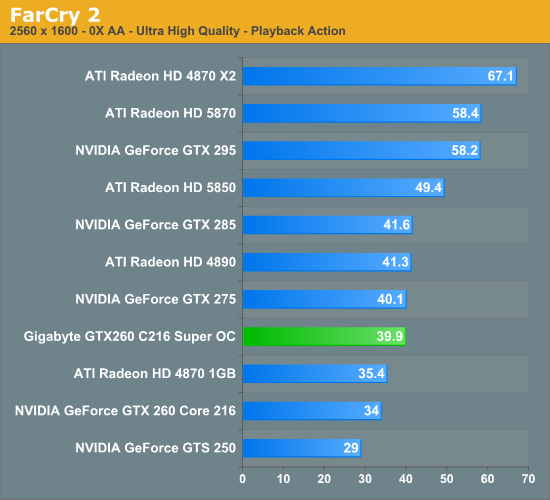


Far Cry 2 presents us with some particularly interesting results. Once again we see the GTX 260 Super Overclock doing well, but in this game in particular it’s doing extremely well. At our lower resolutions it doesn’t just beat the GTX 275, but it also beats the GTX 285, only finally falling back into line at 2560x1600. We suspect that Far Cry 2 may be more sensitive to core overclocking than other titles, as the 680MHz core speed of the GTX 260 Super Overclock is higher than any other GT200b based card. On paper at least, this gives the GTX 260 Super Overclock the ability to push geometry even faster than the GTX 285, which could be what we’re seeing.
BattleForge
BattleForge is EA’s card-based online-only RTS. As the first DirectX11 title it’s of particular importance for the latest rendition of DirectX, although in this case we aren’t using any features that would be impacted by it. Even without ambient occlusion, BattleForge manages to be a rather punishing game for GPUs.
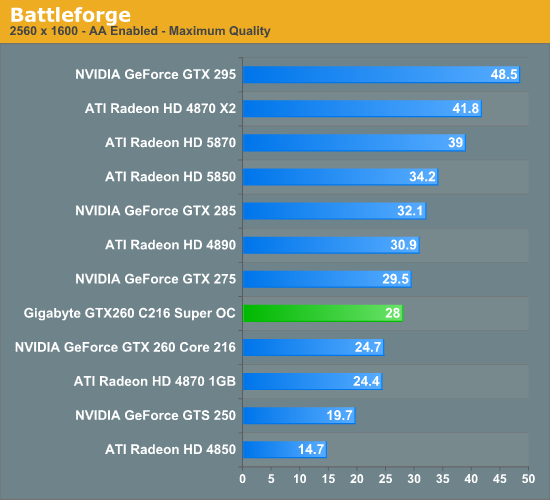

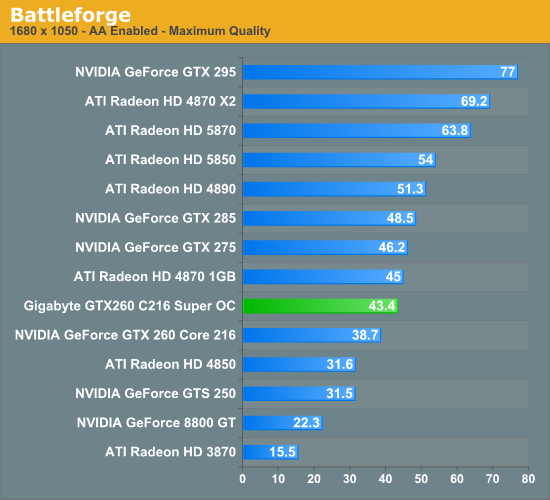
Whereas Far Cry 2 was the title that put the GTX 260 Super Overclock in the best light, Battleforge puts it in the worst. Here it always falls just behind the GTX 275, and this is the only time that we’re going to see that happen. Battleforge is pretty hard on shaders, where the GTX 275 has a slight advantage due to the fact that overclocking alone won’t make up for the 32 SP deficiency between a GTX 260 Core 216 and a GTX 275. This is likely what we’re seeing in action here.
HAWX
HAWX is a game that’s not particularly GPU-bound, which means we can turn in some high numbers.
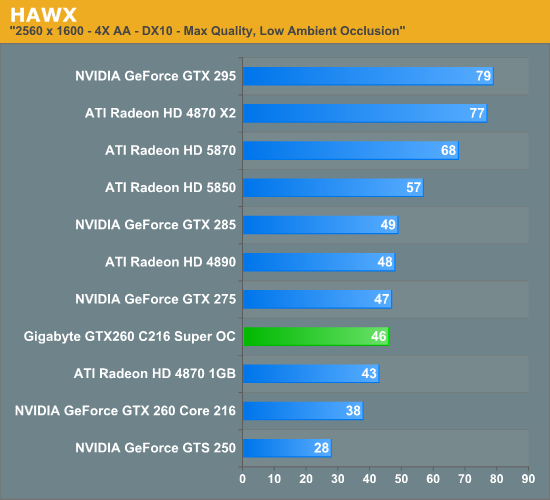


Once again Gigabyte’s GTX260 Super Overclock does well here, only falling behind the GTX275 at 2560x1600. Interestingly, the performance delta between it and the GTX275 changes with the inverse of the resolution, giving it a more noticeable lead at 1680x1050.
Dawn of War II
Dawn of War II is our other RTS benchmark. It’s among the more challenging games in our collection, leading to there being a definite cutoff for playability.
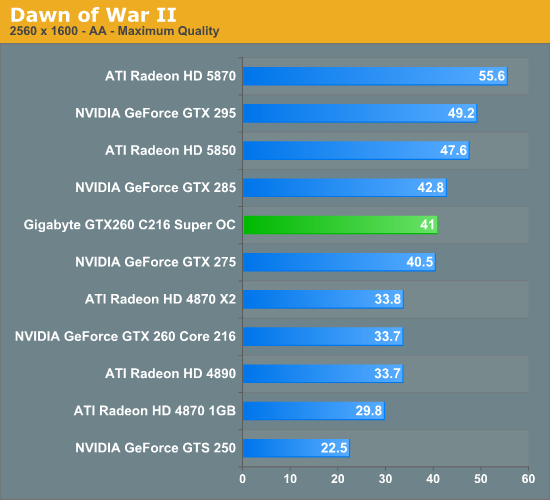

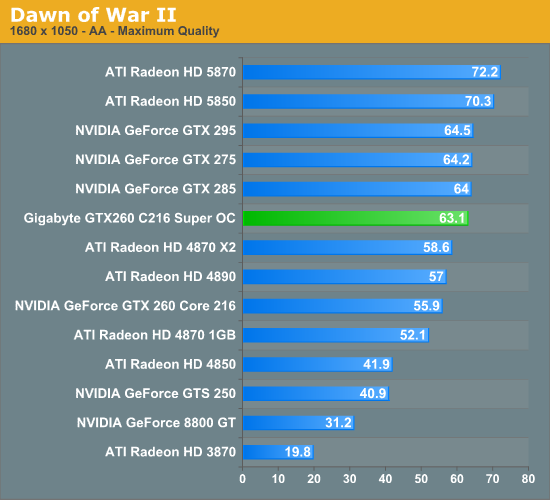
Once again, the GTX260 Super Overclock manages to squeeze past the GTX275 at most resolutions. In the case of Dawn of War, performance on NVIDIA GPUs tends to plateau around the performance level of the GTX275, meaning the GTX260 Super Overclock gets eerily close to the GTX285.
Resident Evil 5
The latest installment of Capcom’s popular survival horror series just arrived for PCs a few days ago. As is often the case with console ports, it’s not particularly GPU starved, and can crank out high numbers on just about anything.
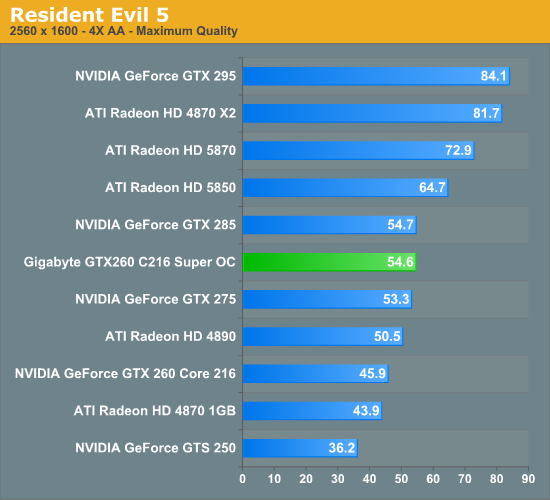
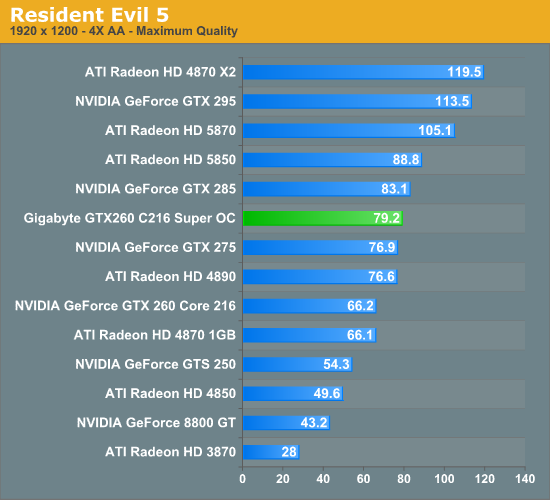
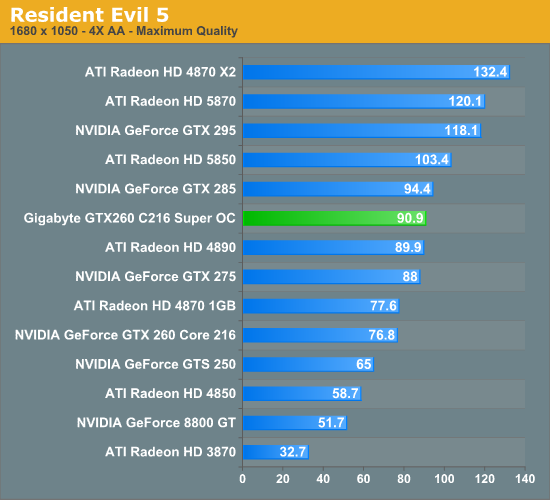
Another chart, another round of the GTX260 Super Overclock and GTX275 trading blows.
Batman: Arkham Asylum
Batman: Arkham Asylum is another brand-new PC game, and has been burning up the review charts. It’s an Unreal Engine 3 based game, something that’s not immediately obvious from just looking at it, which is rare for UE3 based games.
As Batman: Arkham Asylum implements anti-aliasing differently between AMD and NVIDIA cards, this is the one title that we do not test AA on, as doing so produces results that can’t be compared.
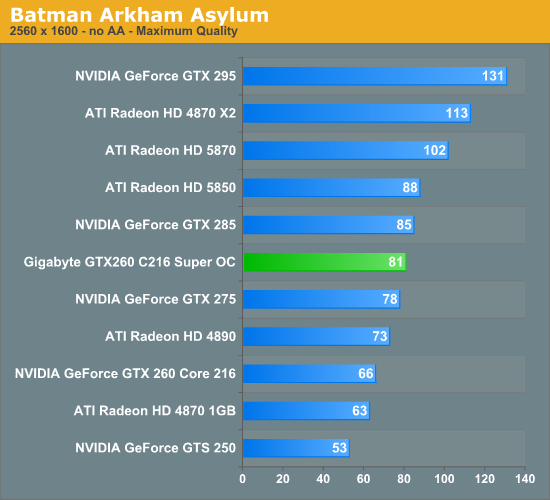
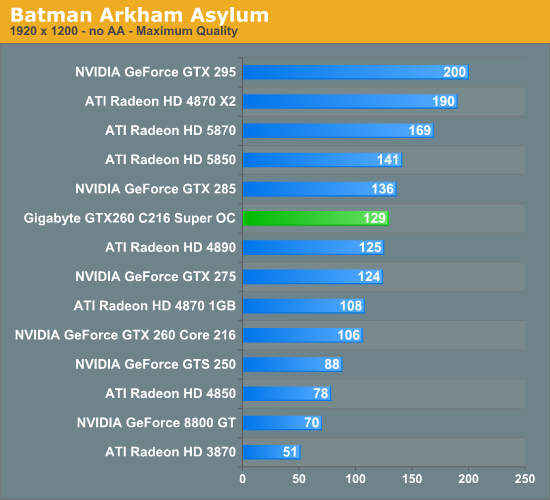
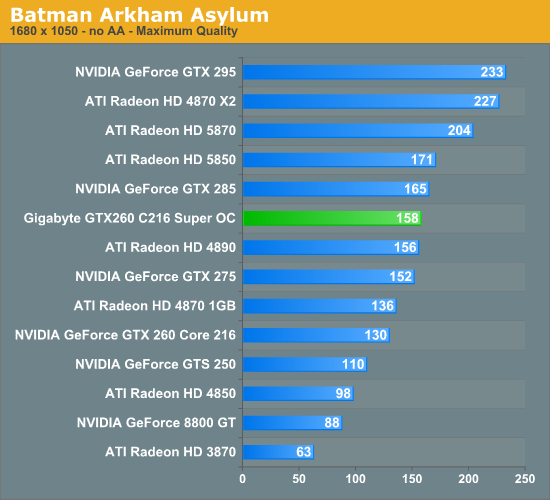
Arkham Asylum is the closest Gigabyte’s GTX260 Super Overclock gets to separating itself from the GTX275. It’s still not much, but it always beats the GTX275 by at least a few frames. Of course without AA, even the regular GTX260 produces a more than playable framerate here.
Left 4 Dead
Valve’s venerable Source engine continues to roll on with Left 4 Dead, their co-op zombie shooter. As the Source engine is CPU limited, this is once again going to be a collection of ridiculously high frame rates.
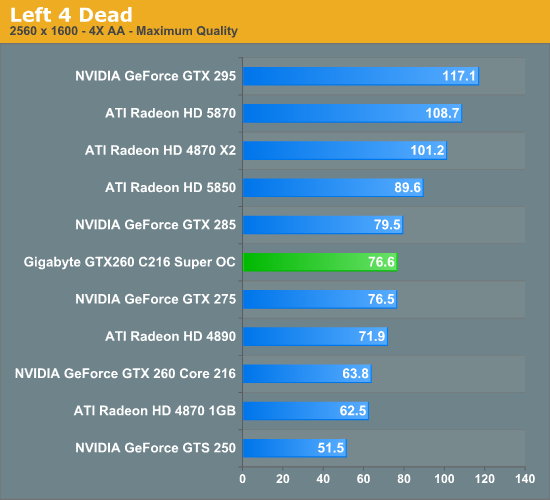
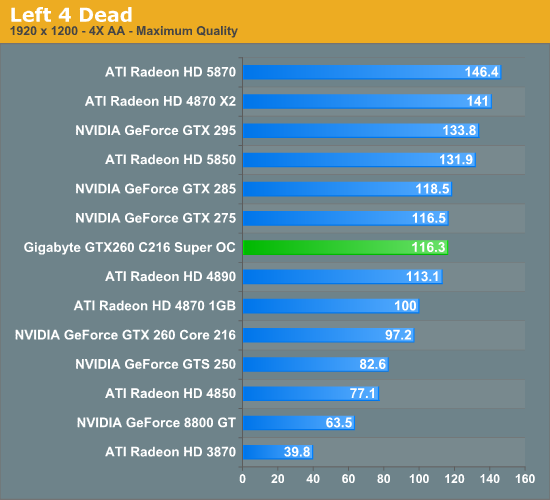
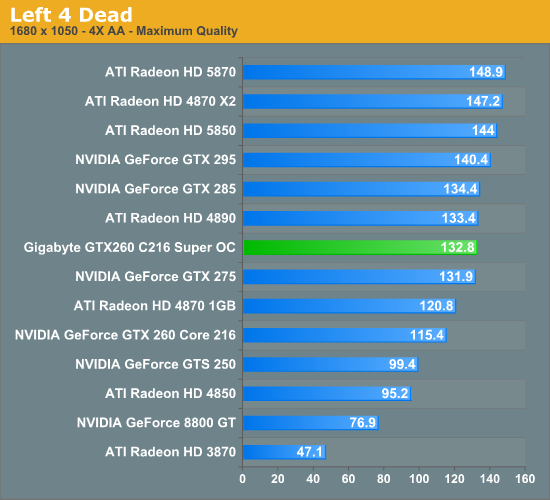
At less than a 1% difference between the GTX 260 Super Overclock and the GTX 275, this Left 4 Dead makes for a dead heat in performance. It’s not even until we get to the higher resolutions that we see the GTX 285 pull away from its lesser brothers, and bear in mind that this is with 4x AA.
Overclocking
Since the GTX260 Super Overclock is a card geared towards overclocking, we decided to push it a bit more and see what we can get. Gigabyte’s press materials claim that they pick a point below the limit of the card, in order to balance power consumption with performance. If that’s the case, we should be able to get a bit more out of it.
In this case, we got 720MHz/1563MHz/2600MHz out of the core, shaders, and memory respectively. This is a 5% core overclock, 4% shader overclock, and 4% memory overclock as compared to the default settings on the GTX260 Super Overclock, and a 25%/26%/30% overclock over the stock GTX 260 Core 216.
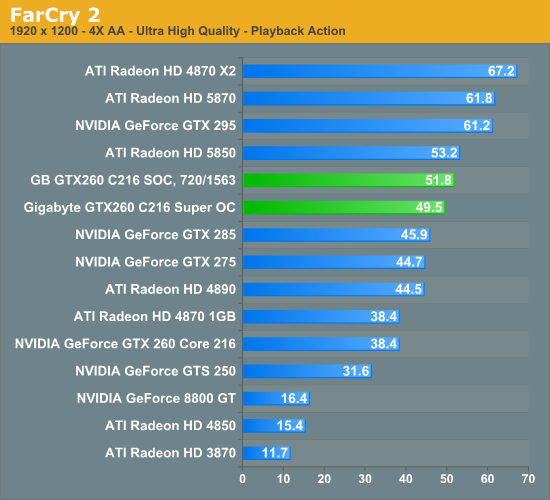
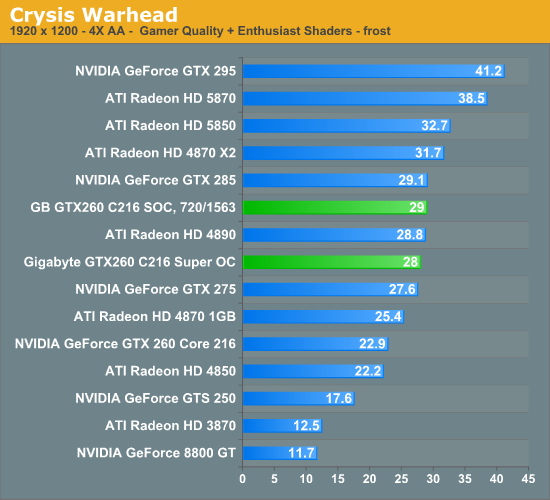
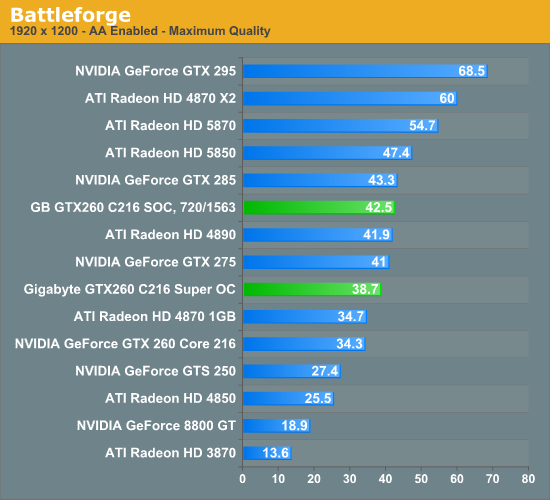
Ultimately while it’s true that there was some room left for overclocking, clearly Gigabyte has already squeezed out most of what they can. The performance boost offered by overclocking nets us a frame or two, but it doesn’t make nearly the different that Gigabyte’s initial overclock did. At best, it cements the GTX260 Super Overclock’s lead over a stock GTX275.
Free performance is free performance, but this card is clearly geared towards people that want the benefits of overclocking without the hassle or the warranty risk. If you’re looking for something specifically to overclock, this card isn’t going to be for you.
Temperature & Noise
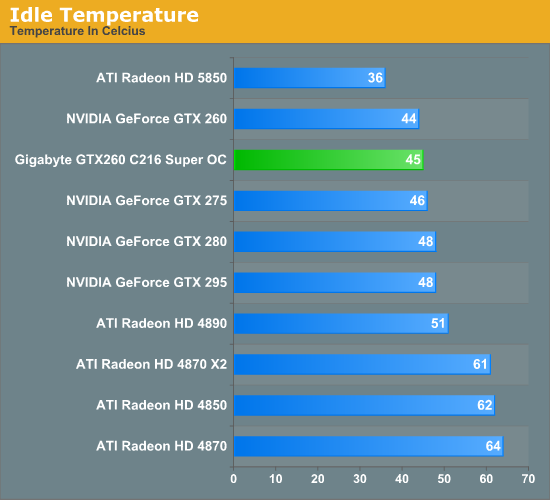
The GTX 260 Super Overclock idles roughly at par with the rest of the GTX lineup, coming in behind the GTX 275 and ahead of an original GTX 260. It can’t however touch the 5850, which has a significantly lower idle power uage.
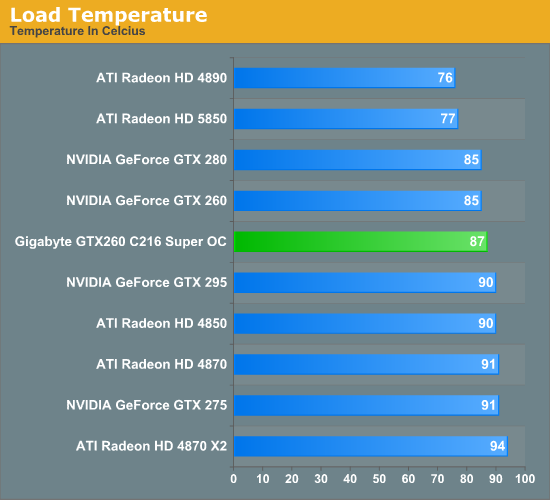
The cost of running a GTX 260 as such high clockspeeds makes itself apparent here, as the GTX 260 Super Overclock ends up being a few degrees warmer than either the original GTX 260 or the GTX 280. However it easily sails in under the GTX 275, which at 91C is pushing the level where the drivers will significantly ramp up fan speeds to maintain temperature.
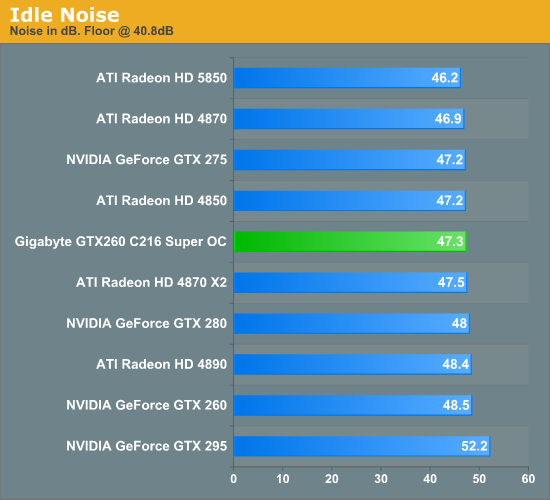
The noise at idle is in line with virtually everything else we have tested. All of these cards highlight the fact that there exists a point where you can’t get noticeably quieter without going entirely passive.
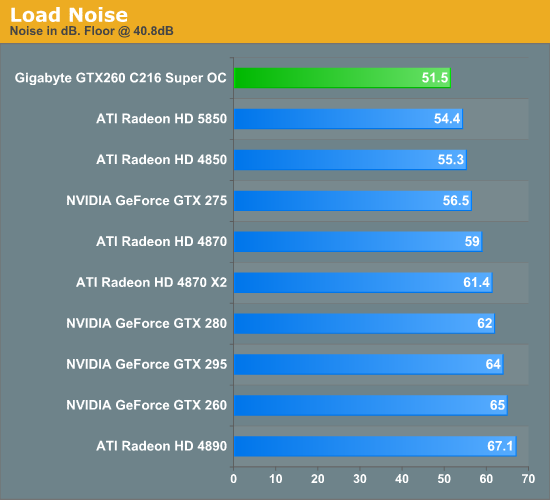
At load, the GTX 260 Super Overclock comes in under everything else on this chart by at least 3dB. This is where Gigabyte’s binning and tuning become apparent, as they have managed to pick a fairly cool chip, and keep the cooler running at a lower speed for longer. The higher temps we saw earlier are a direct result of the desire to keep load noise lower. The card does get hot enough to drive the fan higher, but less so than if Gigabyte wanted to keep the GTX 260’s original thermal targets. In practice this combination makes it one of the quietest higher-end cards we have tested.
Conclusion
Typically, vendor-overclocked cards are used as a tool to patch pricing gaps in a product lineup. They allow a vendor to offer better performance than a stock card, thereby justifying a higher price and for the vendor a higher profit margin.
Gigabyte has gone beyond just filling the void between a GTX 260 Core 216 and a GTX 275. With the GTX 260 Super Overclock, they have produced a card just as fast as a GTX 275 with a lower price. Gigabyte has put the MSRP on this card at $199, while we can’t get a GTX 275 at anything under $209. It’s only $10, but at the same time, what’s the difference between a GTX 275 and a GTX 260 that performs at the same level?
At this time it’s hard to justify purchasing a GTX 275 with the GTX 260 Super Overclock on the shelves. Certainly if you intend to do more overclocking on your own the GTX 260 Super Overclock is a poor choice since Gigabyte has already squeezed out most of what they can. But if you’re not the kind of person that overclocks their video cards, the performance of this card is just as good as a GTX 275 but for less. We would laud it for also being a well-built card after it turned in such impressive temperature and noise results, but as it turns out Gigabyte is their own enemy here – their GTX 275 is also an Ultra Durable card, and it’s the $209 GTX 275 we’ve been talking about. So build quality really doesn’t come into play here since we can get a similarly well built GTX 275; the bottom line is all about price.
Pricing alone is a dangerous place to be competing however. With the launch of the 5800 series, AMD has a very fast DirectX 11 card only $60 more at $259. As NVIDIA has not adjusted prices to meet the 5800 series, Gigabyte is left with little wiggle room since the cost of acquiring the basic parts for a GTX 260 from NVIDIA hasn’t changed. We asked Gigabyte about this last week, and in spite of the 5800 launch they have no intention (or no ability) to lower the price of the GTX 260 Super Overclock.
The performance difference between the GTX 260 Super Overclock (or a GTX 275) and a 5850 comes out to around 25% depending on what game and resolution we’re looking at. With a price difference of 30%, the GTX 260 Super Overclock is still a better value based solely off of performance, but it’s very close.
Meanwhile, the Radeon 4890 is around $20 cheaper and trades blows with the GTX 260 Super Overclock depending on what game we’re looking at. Their noise and thermal characteristics greatly differ, but this is a product of our 4890 having clearly been tuned for lower temperatures over less noise. Here the right card is going to depend entirely on what games you’re interested in: if it’s a game the GTX 260 Super Overclock wins at, it’s going to be enough of a margin to justify the price difference.
Ultimately Gigabyte would be in a better position if they could bring in this card at a lower price. By creating a GTX 260 with the performance of a GTX 275, they’ve put this card into the war between the GTX 275 and AMD’s offerings right now – a war NVIDIA and its partners aren’t in a good position to win. $10 cheaper would go a long way to better cement the position of this card.
In conclusion, this leaves us with a 4-step recommendation depending on your situation. If you can afford a Radeon HD 5850, consider it. If you can’t, look at the games you want to play and see if the Radeon HD 4890 is faster. And if it isn’t or you’re otherwise going for a $200 NVIDIA card, Gigabyte’s GTX 260 Super Overclock is a great choice. It has every bit of the more expensive GTX 275’s performance at a lower price. Finally, if you're willing to overclock on your own (YMMV!), Gigabyte's GTX 275 with user overclocking should be able to separate itself from the heavily overclocked GTX 260 SO for just $10 more.







